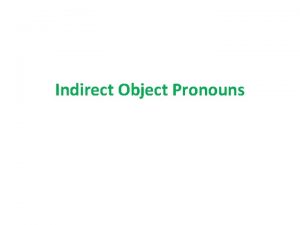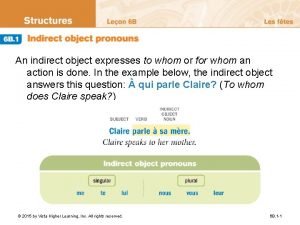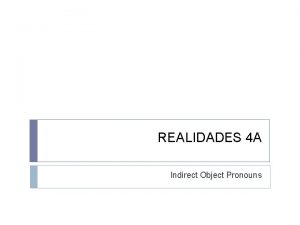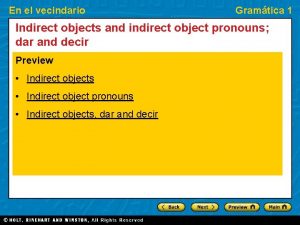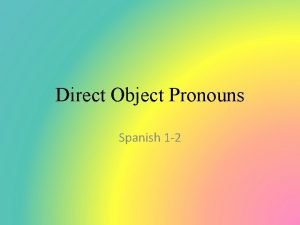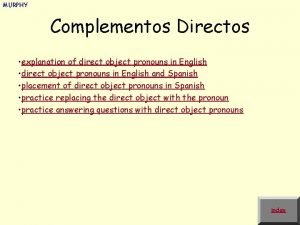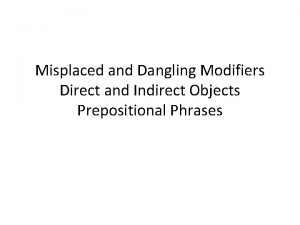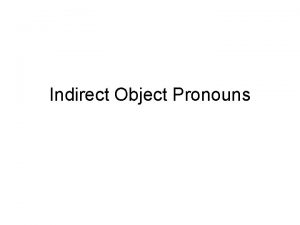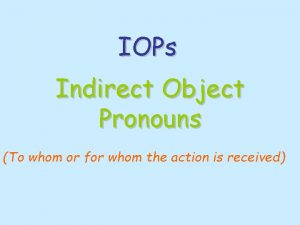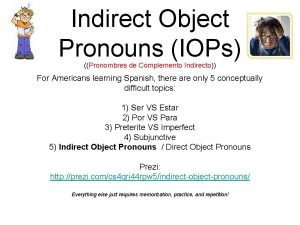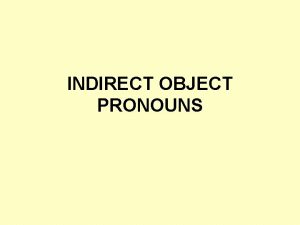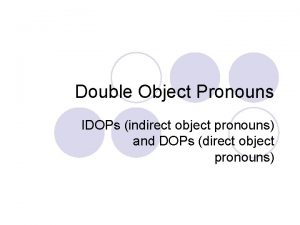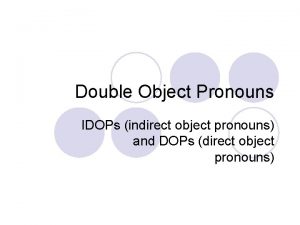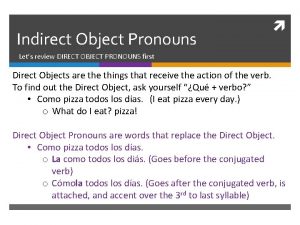IOPs Indirect Object Pronouns IOPs Indirect Object Pronouns

IOP’s Indirect Object Pronouns

IOPs Indirect Object Pronouns • Indirect objects answer the question to whom or for whom. • Receives the direct object. index

What does a indirect object pronoun do? An indirect object pronoun takes the place of an indirect object. For example: Are you giving the truck to Ana? indirect object Yes, I am giving the truck to her. indirect object pronoun index

MURPY What does a indirect object pronoun do? An indirect object pronoun takes the place of an indirect object. For example: Does Ed buy flowers for Maria? indirect object No, he doesn’t buy flowers for her. indirect object pronoun index

The following are the indirect object pronouns in English: The Spanish equivalents are as follows: me = me us = nos you (fam. ) = te you (pl. ) = os you (form. ) = le him = le her = le you (pl. ) = les them (m. ) = les them (f. ) = les index

Notice the placement of the indirect object pronouns in Spanish: Same place as direct object pronouns: before the conjugated verb and attached to the infinitive. I give the money to you. verb Yo te doy el dinero (a ti). indirect object pronoun verb index indirect object pronoun

Notice the placement of the indirect object pronouns in Spanish: 1. Before the conjugated verb 2. Attached to the infinitive. They are going to sing the song to us. indirect object pronoun Ellos van a cantarnos la canción. Ellos nos van a cantar la canción. Conjugated verb index infinitive

In Spanish, whenever you have an Indirect Object, you must : have its corresponding pronoun. Are you going to give Fred the car? indirect object Le vas a dar el carro a Fred? indirect object pronoun index

In Spanish, whenever you have an IOP, you must have : its corresponding pronoun. Maria sends Julia money. indirect object Maria le manda dinero a Julia. indirect object pronoun index

Él no te canta una canción. indirect object pronoun verb direct object Él no te la canta. He doesn’t sing it to her. In a negative sentence in Spanish the indirect object is placed in front of the conjugated verb. It can not be placed in front of “no”. index

Notice the placement of the indirect object pronouns in a negative sentence in Spanish: Mi novio nunca me manda cartas. Mi novio nunca me las manda. My boyfriend never sends them to me. index

Notice the placement of the indirect object pronouns in a sentence with an infinitive construction in Spanish: ¿Quieres mandarme el dinero? Sí, te quiero mandar el dinero. Sí, quiero mandarte el dinero. Sí quiero mandartelo. Sí, te lo quiero mandar. index

Translate the following sentence into Spanish. I give the book to him. Yo le doy el libro (a él). You can’t put le or les + lo, la, los, las. You must change le to se. Yo se lo doy. I give it to him. index

Translate the following sentence into Spanish. We sell the car to her. Nosotros le vendemos el carro (a ella). Se lo vendemos. index

Translate the following sentence into Spanish. They send the letter to us. Ellos nos mandan la carta (a nosotros). Nos la mandan. index

Translate the following sentence into Spanish. She buys the book for Mario and Juan. Ella les compra el libro a Mario y a Juan. Ella se lo compra. index

Translate the following sentence into Spanish. They tell us the truth. Ellos nos dice la verdad (a nosotros). index

Translate the following sentence into Spanish. We send them the letters. Nosotros les mandamos las cartas (a ellos). index

Answer the following question making sure to use a indirect object pronouns. If (no) follows the question answer in the negative. If (sí) follows, answer in the affirmative. ¿Les das el dinero a ellos? (sí) Sí, les doy el dinero (a ellos). index

Answer the following question making sure to use a indirect object pronouns. If (no) follows the question answer in the negative. If (sí) follows, answer in the affirmative. ¿Nos das el carro a nosotros? (sí) Sí, les doy el carro (a Uds. ). index

Answer the following question making sure to use a indirect object pronouns. If (no) follows the question answer in the negative. If (sí) follows, answer in the affirmative. ¿Te mandan cartas a ti? (no) No, no me mandan cartas (a mí). index

Answer the following question making sure to use a indirect object pronouns. If (no) follows the question answer in the negative. If (sí) follows, answer in the affirmative. ¿Te dice ella la verdad a ti? (no) No, no me dice la verdad (a mí). index

Answer the following question making sure to use a indirect object pronouns. If (no) follows the question answer in the negative. If (sí) follows, answer in the affirmative. ¿Les muestra ella el libro a Uds. ? (sí) Sí, nos muestra el libro (a nosotros). index
- Slides: 23

